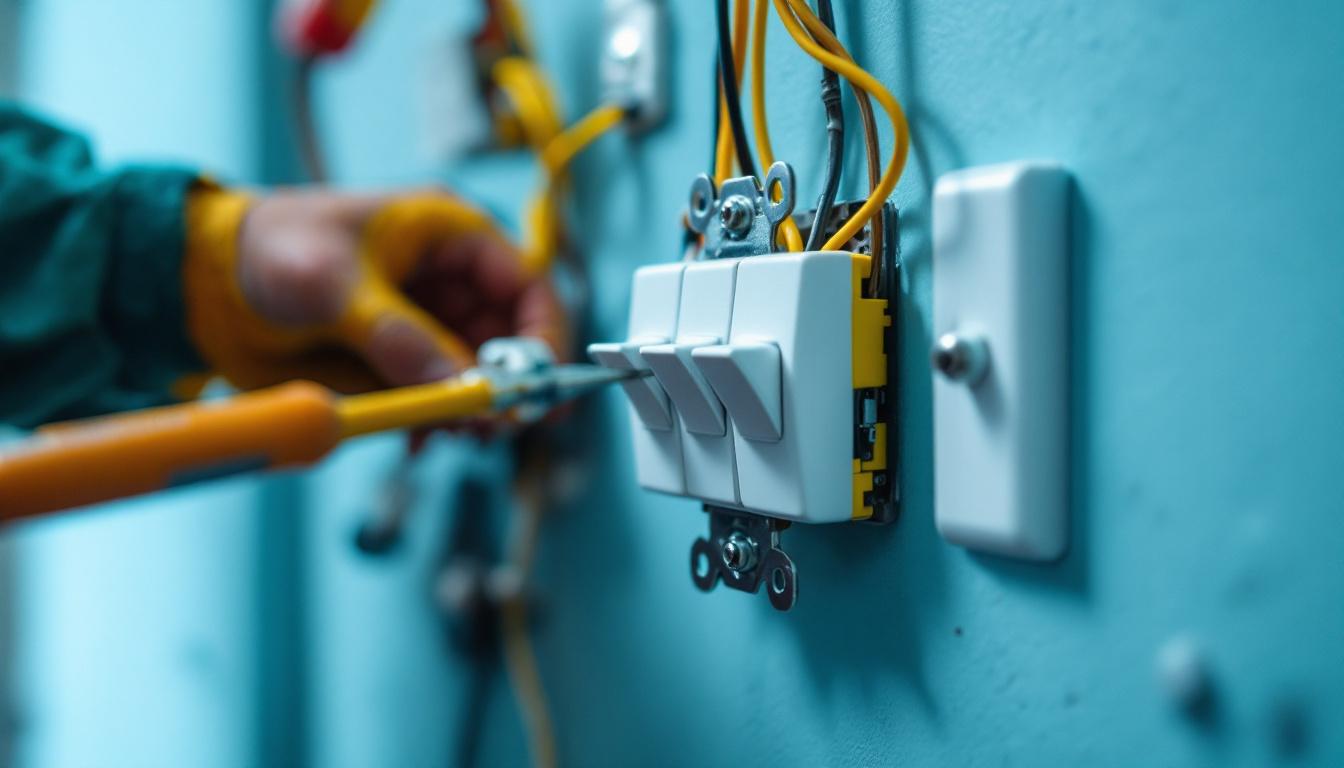
As the demand for efficient lighting solutions continues to grow, understanding the intricacies of electrical components becomes increasingly essential for lighting contractors. Among these components, the 3-way toggle switch stands out as a crucial element in residential and commercial lighting designs. This article delves into best practices for using 3-way toggle switches, aimed specifically at lighting contractors who want to enhance their expertise and provide superior service to their clients.
A 3-way toggle switch allows users to control a single light fixture from two different locations. This feature is particularly useful in larger rooms or hallways where convenience and accessibility are paramount. By grasping the fundamental principles behind how these switches operate, contractors can ensure proper installation and functionality. The versatility of 3-way switches also extends to outdoor lighting, where they can control fixtures from multiple entry points, enhancing safety and usability in dark areas.
At its core, a 3-way switch is designed to control the flow of electricity to a light fixture. Unlike a standard single-pole switch, which has two terminals, a 3-way switch has three terminals: one common terminal and two traveler terminals. The common terminal connects to the power source or the light fixture, while the traveler terminals connect to the other 3-way switch in the circuit.
The unique wiring configuration allows the circuit to be completed through either switch, enabling the light to be turned on or off from either location. Understanding this mechanism is crucial for troubleshooting and ensuring seamless operation. Additionally, it’s important to note that the physical orientation of the switches does not affect their functionality; regardless of whether the switches are up or down, the light will respond according to the circuit’s configuration. This flexibility can be particularly advantageous in homes with varying design aesthetics.
There are several types of 3-way toggle switches available on the market, each designed to meet specific needs. Traditional mechanical switches are the most common, but smart switches have gained popularity due to their advanced features.
Smart 3-way switches can be controlled via smartphone apps or voice commands, offering a modern twist on traditional lighting control. These switches often integrate with home automation systems, allowing users to create schedules or set the mood with dimming capabilities. Contractors should be familiar with both types, as clients may request either option based on their preferences and the specific requirements of the installation site. Furthermore, some smart switches come equipped with energy monitoring features, providing users with insights into their energy consumption and helping to promote more efficient usage of electricity throughout the home.
Proper installation of 3-way toggle switches is vital for ensuring safety and functionality. Following best practices can help contractors avoid common pitfalls and deliver high-quality work.
When wiring a 3-way toggle switch, it is essential to follow the correct color coding and wiring techniques. Typically, the black wire is used for the hot connection, while the white wire serves as the neutral. The traveler wires, often red or another color, connect the two switches.
Contractors should also ensure that all connections are secure and that wire nuts are used to prevent any accidental disconnections. A well-organized and tidy wiring job not only looks professional but also reduces the risk of electrical faults. Additionally, it is advisable to use electrical tape to wrap around the wire nuts for extra security, particularly in areas where vibrations or movement may occur. This small step can significantly enhance the longevity and reliability of the installation.
After installation, testing the 3-way switch setup is crucial. This involves turning the power back on and checking that the light fixture operates correctly from both switch locations. If the light does not respond as expected, troubleshooting may be necessary to identify wiring errors or faulty components.
Using a multimeter can help verify that voltage is present at the switches and that the connections are functioning as intended. This step is essential for ensuring client satisfaction and safety. Furthermore, it’s beneficial to educate clients on how to operate the 3-way switches effectively, including how to troubleshoot simple issues, such as flickering lights, which can often be resolved without professional intervention.
Every region has specific electrical codes and regulations that must be followed during installations. Familiarity with local codes is essential for contractors to ensure compliance and avoid potential legal issues.
Contractors should stay updated on any changes to these codes and incorporate them into their practices. This not only enhances safety but also builds trust with clients who expect professionalism and adherence to standards. Engaging in continuing education or attending local workshops can provide valuable insights into code updates and emerging technologies in electrical installations. By demonstrating a commitment to ongoing learning, contractors can position themselves as knowledgeable experts in their field, further solidifying their reputation among clients and peers alike.
Even experienced contractors can make mistakes during the installation of 3-way toggle switches. Being aware of common pitfalls can help prevent issues that may arise during or after installation.
One of the most common mistakes is neglecting to label wires during the installation process. When working with multiple wires, it can be easy to lose track of which wire connects to which terminal. Labeling each wire as it is disconnected can save time and reduce confusion during reassembly.
Using color-coded labels or tape can be an effective way to keep track of connections, ensuring a smoother installation process and minimizing the risk of errors. Additionally, taking photographs of the wiring setup before disassembly can serve as a useful reference, allowing contractors to visualize the original configuration and double-check their work as they reassemble the switch.
Another critical aspect often overlooked is the ground connection. Proper grounding is essential for safety, as it helps prevent electrical shocks and fires. Contractors must ensure that the ground wire is securely connected to the switch and that it is properly grounded to the electrical box.
Failing to address grounding can lead to serious safety hazards, making it imperative for contractors to prioritize this step during installation. In addition, using a multimeter to test the continuity of the ground connection can provide an added layer of assurance, confirming that the grounding is effective and compliant with local electrical codes.
While technical expertise is vital, understanding and accommodating client preferences is equally important. Contractors should engage with clients to discuss their lighting needs and preferences before finalizing the installation plan.
By taking the time to listen to clients, contractors can tailor their solutions to meet specific requirements, ultimately leading to higher satisfaction and repeat business. Moreover, presenting clients with various switch styles and finishes can enhance their experience, allowing them to choose options that not only function well but also complement their home’s aesthetic. This attention to detail can set a contractor apart in a competitive market, fostering trust and long-term relationships with clients.
Once installed, 3-way toggle switches require minimal maintenance. However, educating clients on how to care for their switches can help prolong their lifespan and ensure optimal performance.
Encouraging clients to conduct regular inspections of their lighting systems can help identify potential issues before they escalate. This includes checking for flickering lights, unusual sounds, or any signs of wear and tear on the switches.
By being proactive, clients can address minor issues promptly, reducing the likelihood of costly repairs or replacements in the future.
Dust and debris can accumulate on switches over time, affecting their performance. Clients should be advised to periodically clean their switches using a soft, dry cloth to remove any buildup.
Contractors can provide clients with simple cleaning tips to ensure their switches remain in optimal condition, further enhancing their overall lighting experience.
As technology evolves, the applications of 3-way toggle switches have expanded beyond traditional uses. Contractors should be aware of innovative ways to integrate these switches into modern lighting designs.
With the rise of smart home technology, integrating 3-way toggle switches with smart systems can enhance user experience. Smart switches can be programmed to work with home automation systems, allowing users to control lighting remotely or set schedules for energy efficiency.
Contractors who are knowledgeable about smart home integration can offer clients advanced solutions that align with contemporary living trends, setting themselves apart in a competitive market.
In larger spaces, utilizing multiple 3-way toggle switches can facilitate multi-zone lighting control. This allows different areas of a room or building to be lit independently, providing flexibility and energy savings.
Contractors can design lighting systems that cater to specific activities or moods, enhancing the overall functionality of the space while appealing to clients’ preferences.
Mastering the installation and application of 3-way toggle switches is an essential skill for lighting contractors. By understanding their functionality, adhering to best practices, and avoiding common mistakes, contractors can deliver high-quality installations that meet client needs.
Furthermore, staying informed about innovative applications and maintenance tips can enhance the longevity and performance of lighting systems. As the industry continues to evolve, embracing new technologies and methods will ensure that contractors remain competitive and successful in their field.
Ultimately, the goal is to provide clients with safe, efficient, and aesthetically pleasing lighting solutions that enhance their spaces and improve their quality of life.
Ready to elevate your lighting installations with the best 3-way toggle switches on the market? Look no further than LumenWholesale, where we offer spec-grade lighting products that meet the highest industry standards. Say goodbye to inflated markups and hello to unbeatable wholesale prices, free shipping, and the convenience of bulk buying. Enhance your lighting projects with reliable, high-performance switches that will impress your clients and improve their quality of life. Visit LumenWholesale today and discover the perfect blend of quality, affordability, and convenience for all your lighting needs.

Discover the frequent pitfalls lighting contractors encounter with tubular lamp bulbs.

Discover why staying informed about 4′ LED strip lights is crucial for lighting contractors.

Discover how hiring professional lighting contractors can transform your home and elevate your business.

Discover essential exterior residential lighting tips contractors often overlook.